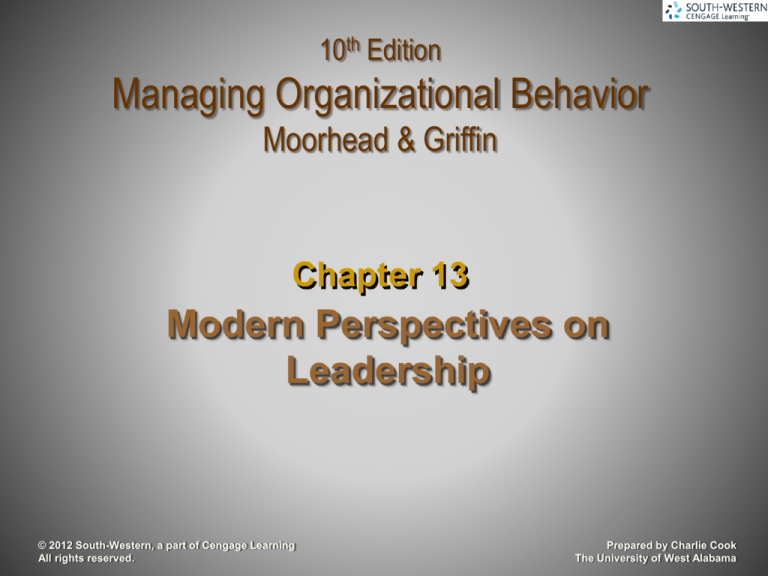
10th Edition
Managing Organizational Behavior
Moorhead & Griffin
Chapter 13
Modern Perspectives on
Leadership
© 2012 South-Western, a part of Cengage Learning
All rights reserved.
Prepared by Charlie Cook
The University of West Alabama
Chapter Learning Objectives
After studying this chapter you should be able to:
• Identify and describe contemporary situational theories
of leadership.
• Discuss leadership through the eyes of followers.
• Identify and describe alternatives to leadership.
• Describe the changing nature of leadership.
• Identify and discuss emerging issues in leadership.
© 2012 South-Western, a part of Cengage Learning
13–2
Contemporary Situational Theories
• New situational theories have evolved from
LPC theory, Path-Goal theory, and the Decision
Tree Model:
–The Leader-Member Exchange Model
–The Hersey and Blanchard Model
–Attributions of Leadership
–Updated versions of the original models
© 2012 South-Western, a part of Cengage Learning
13–3
Contemporary Situational Theories (cont’d)
• The Leader-Member Exchange
Model (Graen and Dansereau)
–Suggests that leaders form unique
independent relationships with each
of their subordinates
–A key factor in the nature of this
relationship is whether the individual
subordinate is in the leader’s outgroup or in-group
© 2012 South-Western, a part of Cengage Learning
13–4
13.1
The Leader-Member Exchange (LMX) Model
© 2012 South-Western, a part of Cengage Learning
13–5
Contemporary Situational Theories (cont’d)
• The Hersey and Blanchard Model
–Suggests that leader behaviors should vary in
response to the “readiness” of followers
• As follower readiness (i.e., subordinate’s degree of
motivation, competence, experience, and interest in accepting
responsibility) improves, the leader’s relationship style should
change from telling to selling to participation to delegating
while the leader’s task behavior (initially high) should diminish
over time
© 2012 South-Western, a part of Cengage Learning
13–6
13.2
The Hersey and Blanchard Theory of Leadership
© 2012 South-Western, a part of Cengage Learning
13–7
Leadership Through the Eyes of Followers
Approaches to Leadership
Transformational
Leadership
© 2012 South-Western, a part of Cengage Learning
Charismatic
Leadership
Attributions of
Leadership
13–8
Leaders as Followers See Them
Transformational
Leadership
The set of abilities that allows the leader to
recognize the need for change, to create a
vision to guide that change, and to execute the
change effectively.
Charismatic
Leadership
Charisma is a personal characteristic of the
leader which inspires support and acceptance.
Leadership is based on leader’s personal
charisma.
Attributions of
Leadership
Holds that when behaviors are observed in a
context associated with leadership, others may
attribute varying levels of leadership ability or
power to the person displaying those behaviors.
© 2012 South-Western, a part of Cengage Learning
13–9
13.3
The Charismatic Leader
Reference: David A. Nadler and Michael L. Tushman, “Beyond the Charismatic Leader: Leadership
and Organizational Change,” California Management Review, Winter 1990, pp. 70–97.
© 2012 South-Western, a part of Cengage Learning
13–10
Alternatives to Leadership
Alternatives to
Leadership
Leadership
Substitutes
© 2012 South-Western, a part of Cengage Learning
Leadership
Neutralizers
13–11
13.1
Substitutes and Neutralizers for Leadership
© 2012 South-Western, a part of Cengage Learning
13–12
The Changing Nature of Leadership
• Leaders as Coaches
–New Role: Leader as Mentor
• Help select team members and
other new employees
• Provide general direction
• Help train/develop the team and
member skills
• Help acquire information/resources
• Help resolve conflict and mediate
disputes
© 2012 South-Western, a part of Cengage Learning
13–13
The Changing Nature of Leadership (cont’d)
• Gender and Leadership
–Stereotyping of styles is no longer valid
–Women tend to be more democratic decision makers;
men more autocratic
–Women may have stronger interpersonal skills
–Women may confront more opposition and therefore
involve others in decision making to reduce conflict
• Cross-Cultural Leadership
–Culture encompasses both international differences
and diversity-based differences within one culture
© 2012 South-Western, a part of Cengage Learning
13–14
Emerging Issues in Leadership
Leadership Issues
Strategic
Leadership
© 2012 South-Western, a part of Cengage Learning
Ethical
Leadership
Virtual
Leadership
13–15
Emerging Issues in Leadership (cont’d)
• Strategic Leadership
–Requires that leaders be capable of:
• Understanding the complexities of both the organization and
its environment
• Leading change in the organization to achieve and maintain a
superior alignment between the organization and its
environment
–Managerial requirements:
• Encompassing understanding of the organization
• Firm grasp of the organization’s environment
• Awareness of firm’s alignment with the environment
• Ability to improve the alignment
© 2012 South-Western, a part of Cengage Learning
13–16
Emerging Issues in Leadership (cont’d)
• Why Ethical Leadership Is Essential
–Increasing pressure for high ethical standards for
leadership positions
–Increasing pressure to hold leaders accountable for
their actions
–Increasing environmental pressure for stronger
corporate governance models
© 2012 South-Western, a part of Cengage Learning
13–17
Emerging Issues in Leadership (cont’d)
• Virtual Leadership Challenges
–Changes in leadership and mentoring as in-person
contact replaces virtual contact
–Less nonverbal communication
–Increasing importance of e-mail’s role in conveying
appreciation, reinforcement, and constructive
feedback
–Face-to-face leadership skills become critical as
opportunities decrease for direct contact
© 2012 South-Western, a part of Cengage Learning
13–18
Organizational Behavior in Action
• After reading the chapter:
–What behavior do you most readily identify as
“leadership”?
–What could substitute for a professor’s leadership in
the classroom? (Think lower tuition !!!)
© 2012 South-Western, a part of Cengage Learning
13–19







